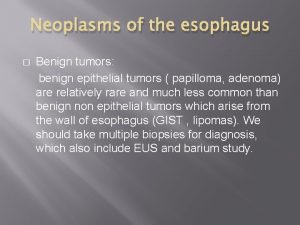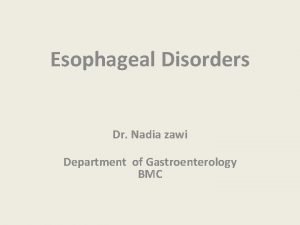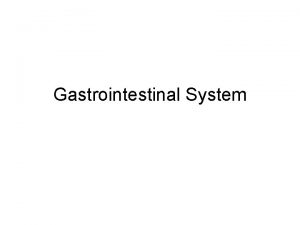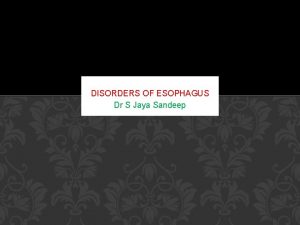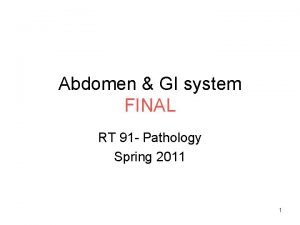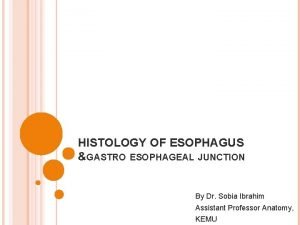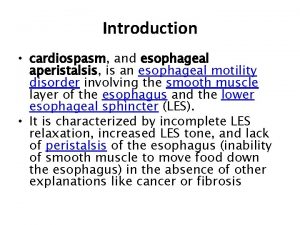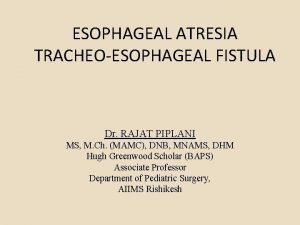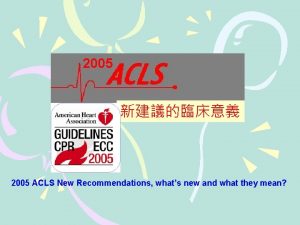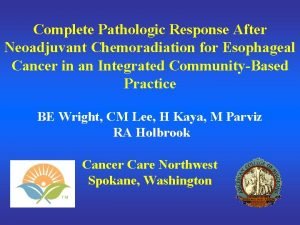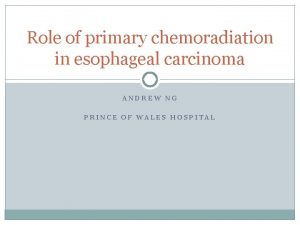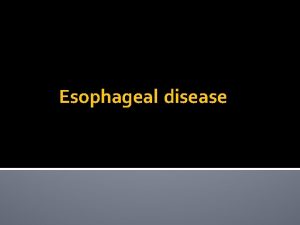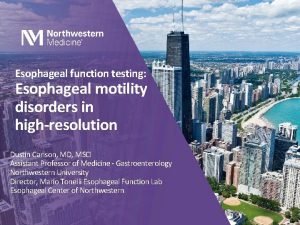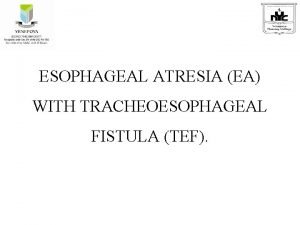Esophageal Cancer New updates in Chemoradiation Dr Hamid










- Slides: 10

Esophageal Cancer , New updates in Chemoradiation Dr Hamid Reza Dehghan Manshadi Radiation Oncologist Iran University of Medical sciences

• Primary tumor(T) • • • Staging Tis : Carcinoma in situ (Severe dysplasia) T 1: Lamina Properia or submucosa T 2 : Muscularis properia T 3 : Invades Advantitia T 4: Invades Adjacent structures (T 4 a : resectable T 4 b : unresectable) • Regional Lymph Nodes (N) : • regional LN Mts N 0 , N 1 (No. of LNs? ) • Distant Metastasis(M) : M 0 , M 1 • • • Lower Thoracic : M 1 a : Celiac LNs M 1 b : Other Distant Mts Mid Thoracic : M 1 a : not Applicabale M 1 b : nonregional LNs and / or other distant Mts Upper Thoracic ; M 1 a : Cervical LNs M 1 b : other distant Mts • Point : GEJ tumors included in esophageal Tumor Staging STAGE 1 ; T 1 N 0 M 0 Stage IIA : T 2/T 3 N 0 M 0 Stage IIB : T 1/T 2 N 1 M 0 Stage III : T 3 N 1 M 0/ T 4 any. NM 0 • Stage IVA : any. T any. N M 1 a • Stage IVB : any. T any. N M 1 b • •

Evaluations for Staging • Barium swallow • CT Scanning: nodal staging 29%-42%, poor for T staging • EUS : 89% for T, 75% for N • EUS / FNA : 89% for T , 87% for N • PET/ CT: more accurate for Mts. 20% unnecessary surgery reduction • Laparoscopy and Thoracoscopy • Bronchoscopy

SQUAMOUS CELL VERSUS ADENOCARCINOM • • • Incidence : 16, 470 diagnosis, 14, 530 deaths SCCs tend to arise 10 years earlier The pattern of first recurrence after resection: locoregional vs distant Mts Better Survival in Adenocarcinoma? • Conclusion : • The treatment plan and OS are the same

localized cancers of the esophagus and esophagogastric junction • • • SURGERY ALONE only 30 to 40 percent of patients have potentially resectable disease at presentation, five-year survival rates of 15 to 20 percent for surgery alone RT ALONE : 60 to 66 Gy over a period of 6 to 6. 6 weeks survival rates of 5 to 20 percent With 3 D planning techniques and 69 Gy dose 3 & 5 years survival was the same as surgery alone ((61 and 37 percent)(SCC only) CHEMORADIOTHERAPY : RTOG 85 -01 : comparing RT alone(64 Gy) vs Chemoradiation (Cis 75 mg/m 2 + 5 fu infusional 1000 mg/m 2 d 1 d 4, week 1&5 + 50 Gy RT) result was excellent for Chemoradiation group Intergroup 0123: comparing 50. 4 Gy RT + chemo with 64 Gy RT + Chemo No better results with higher tumor doses Preoperative chemoradiotherapy Irish sutdy : Chemoradiation vs surgery alone, improved median (16 versus 11 months) and three-year survival (32 versus 6 percent)

• Michigan study: 100 pts, locoregional spread (SCC, Adeno), randomized for surgery alone or induction chemoradiation (cis/5 fu/vbl) better locoregional control, better 3 years survival • 3 other study compared sequential chemotherapy+RT + surgery vs surgery alone showed no significant improvement • Induction chemotherapy and concurrent chemoradiotherapy : • Swedish trial : 12 -16 weeks chemotherapy chemoradiation +surgery , result: no significant survival imrovement • NEOADJUVANT CHEMOTHERAPY: • 8 trials meta-analysis revealed no significant improvement in 2 years survival in SCC but significant benefit with Adenocarcinoma(UK MRC trial)

• • INDUCTION CHEMORADIOTHERAPY VERSUS CHEMOTHERAPY The multicenter German POET: comparing induction chemotherapy to chemoradiation in GE Adenocarcinomas patients undergoing chemoradiotherapy had better median (33 versus 21 months) and three-year survival (47 versus 28 percent, p = 0. 07) CERVICAL ESOPHAGUS TUMORS SUMMARY AND RECOMMENDATIONS: After chemoradiation , inclusion of surgery is preferred for clinically resectable esophageal cancer regardless of histology concurrent trimodality approach (concomitant chemoradiotherapy followed by surgery) provides a survival benefit compared to surgery alone local control appears to be better with preoperative chemoradiotherapy compared to surgery alone • It is suggest combined modality therapy using preoperative chemoradiotherapy followed by surgery rather than either surgery alone or definitive chemoradiotherapy for patients with stages IIA, IIB, and III esophageal SCC or adenocarcinoma of the distal esophagus or EGJ

Chemoradiation regimens • Infusional 5 -FU 1000 mg/m 2 per day for 96 hours during weeks 1 and 5 of external beam radiation therapy (EBRT) Cisplatin 75 mg/m 2, on day 1, during weeks 1 and 5 of EBRT (50. 4 Gy in daily 1. 8 Gy fractions, given concurrently with cycles 1 and 2 of chemotherapy. Post-chemoradiotherapy surgery. Salvage esophagectomy. BRACHYTHERAPY. Endoscopic interventions (dilation, placement of an endoluminal stent, laser, and photodynamic therapy)

• Chemotherapy for Advanced Disease: • • DCF (Docetaxel, Cisplatin, 5 FU), Esp. In GEJ Irinotecan + Cisplatin , Esp, In SCC of esophagus ECF (Epirubicin, Cisplatin, 5 FU) Capecitabin , Oxaliplatin (as effective as Cis/5 FU) • Targeted Therapy: • To. GA Study : Multicenter, phase III study : Cis/5 FU + Trastuzomab (HER-2 + , GE & Gastric Cancer) = Higher Median OS (13. 5 months vs 11. 1 months ) without significant higher toxicity • Cetuximab • Erlotinib • Bevacizumab

